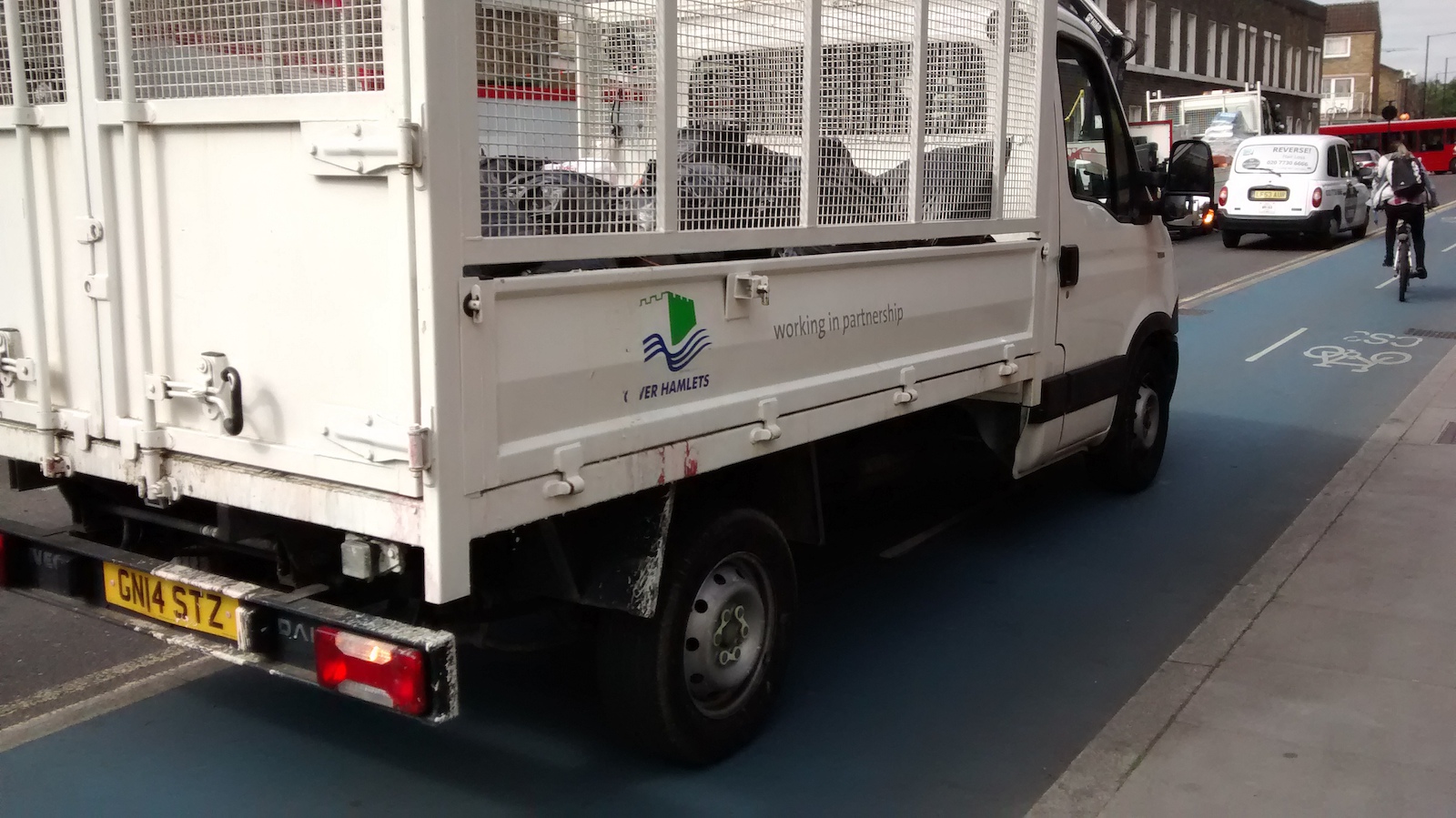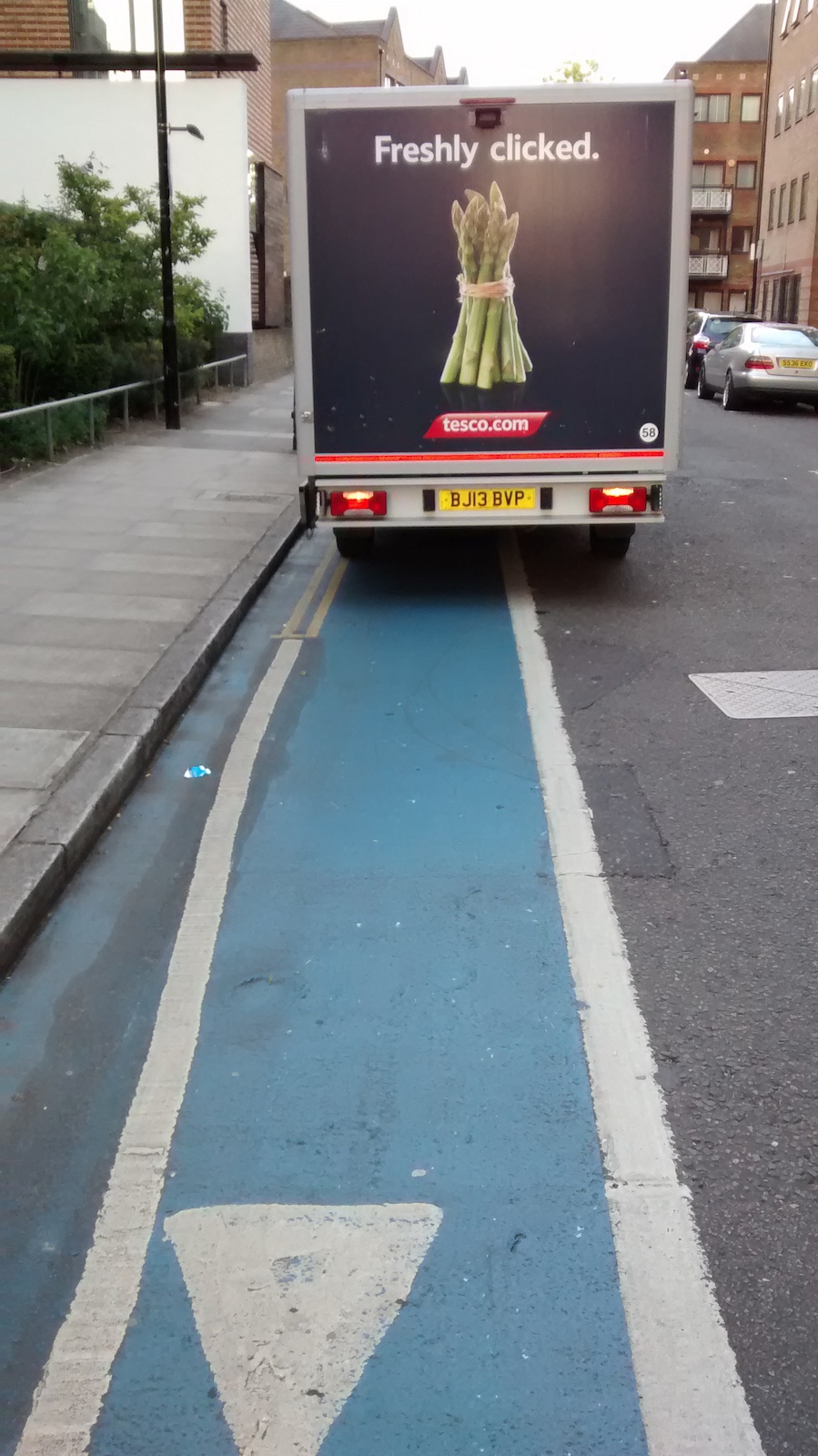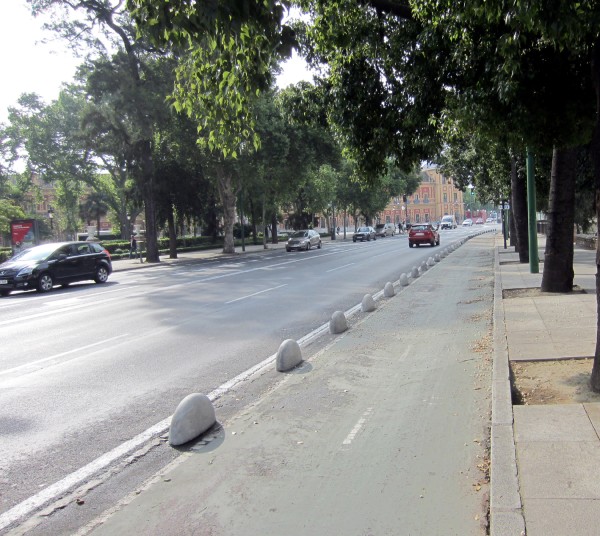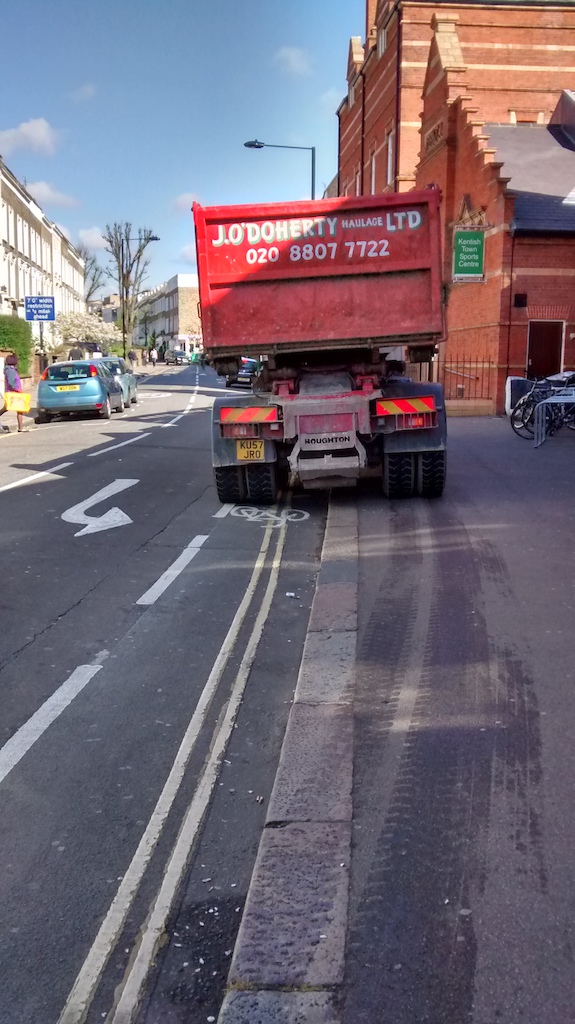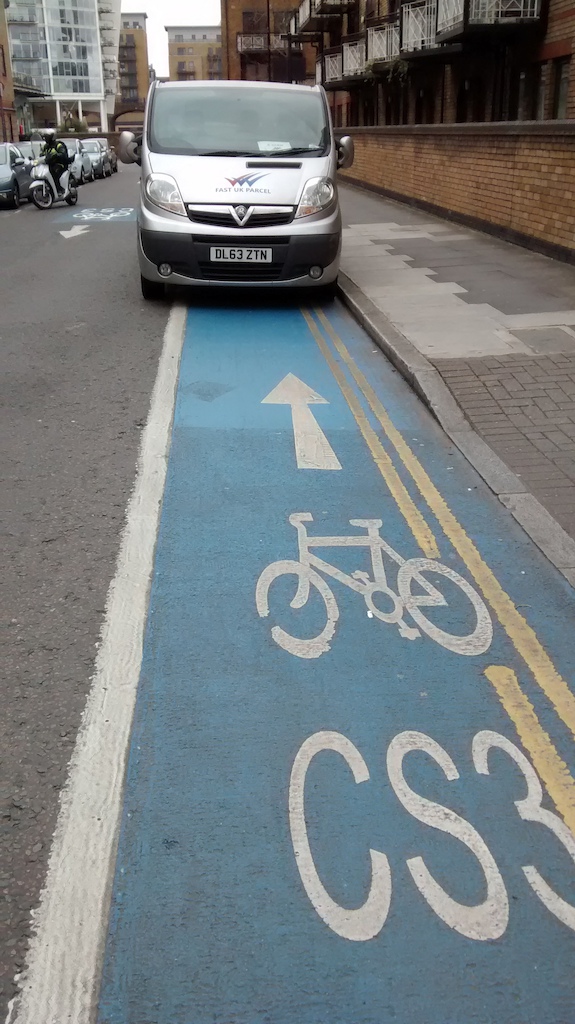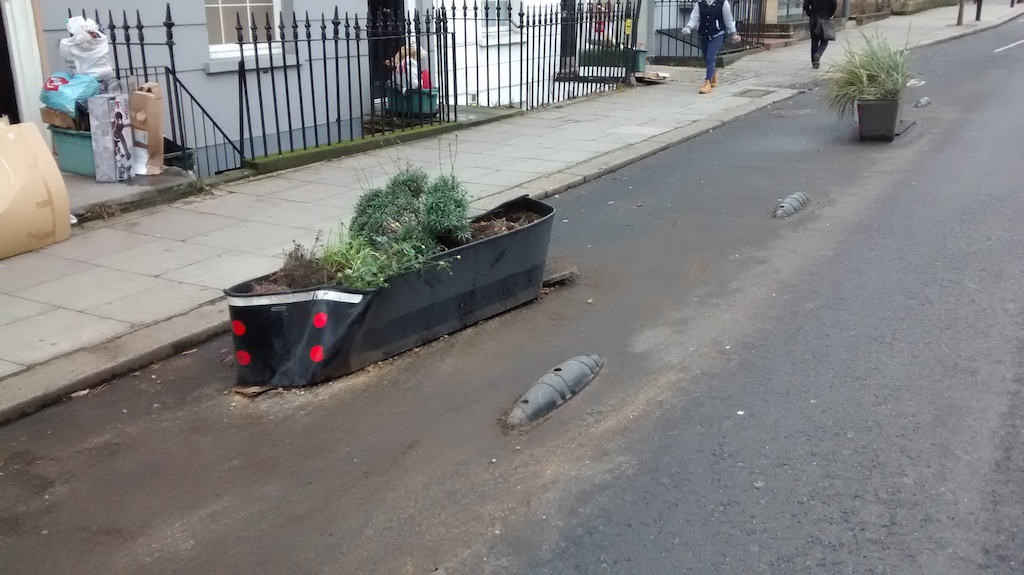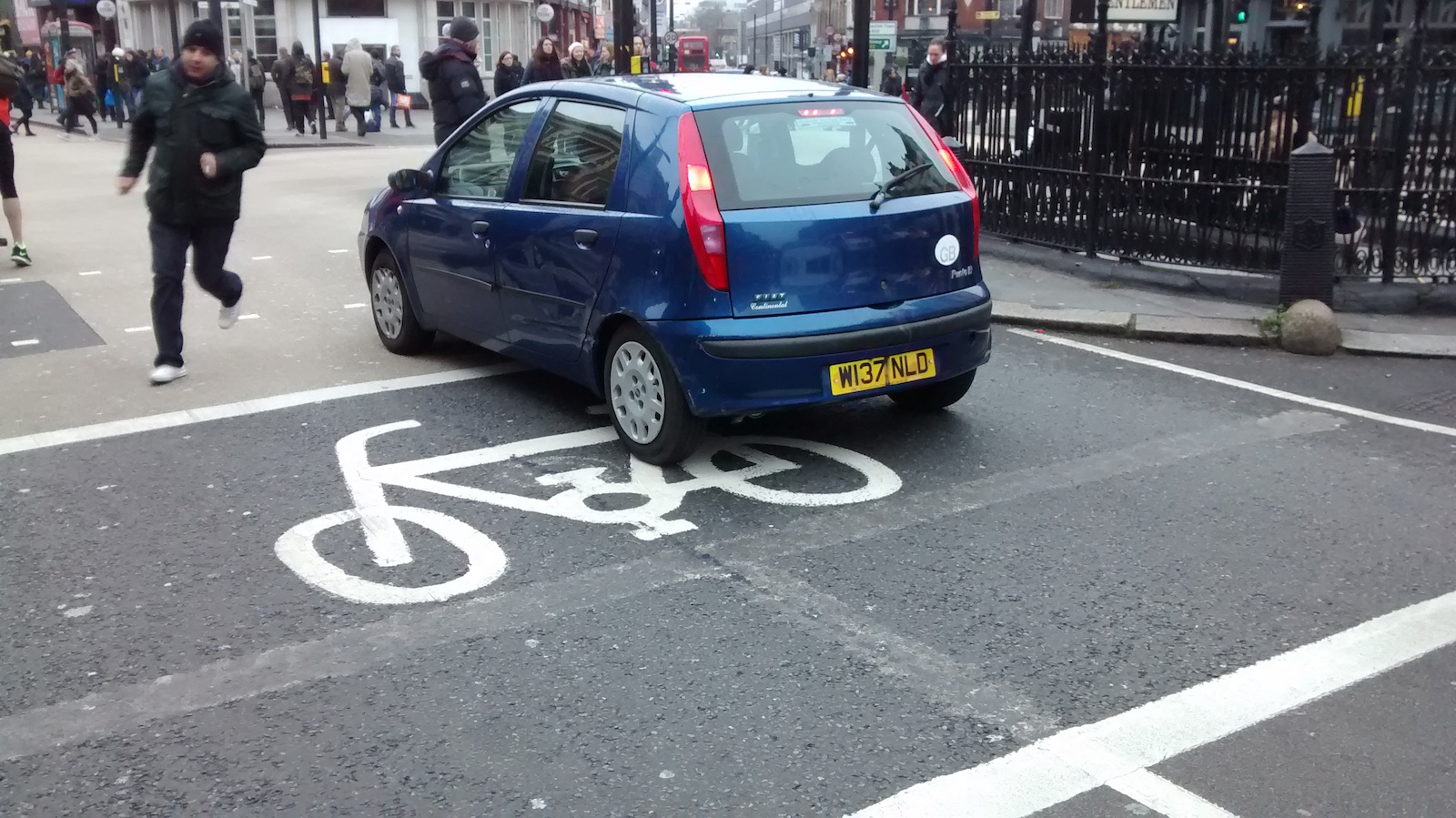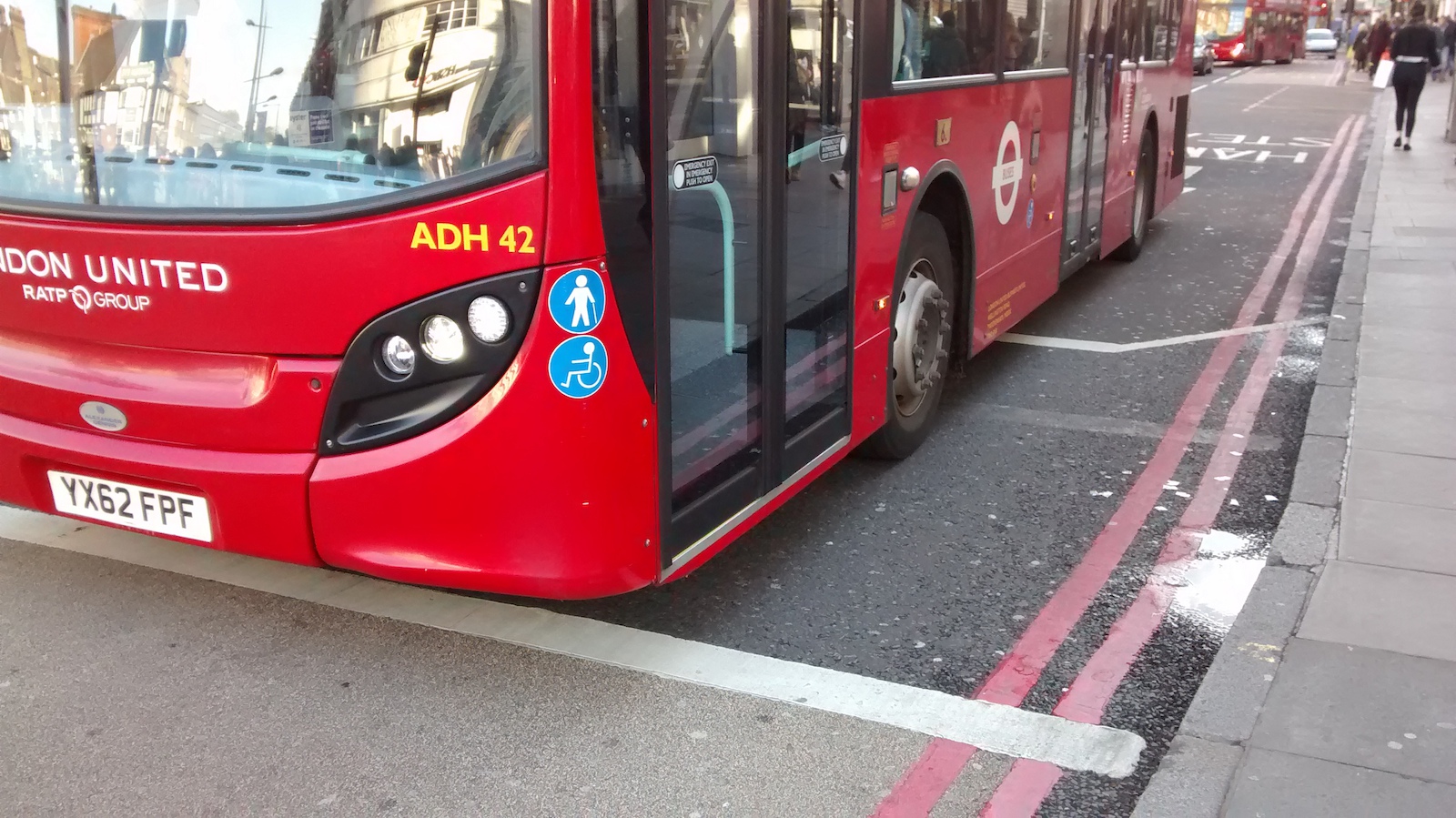![]() You don't need to be an 'investor' to invest in Singletrack: 6 days left: 95% of target - Find out more
You don't need to be an 'investor' to invest in Singletrack: 6 days left: 95% of target - Find out more
Sad to see another cyclist fighting for their life after an incident with a lorry in Camberwell Green.
Is it just me that thinks banning lorries at peak times would not really help? just concentrate them mid morning etc. Zero sum etc.
Surely, what kills cyclists (especially in cities) is bad driving, sometimes bad cycling and very rarely bad infrastructure. Until the Police and judicial authorities take drivers' responsibilities more seriously cyclists will be in unnecessary danger.
Speeding, not indicating, not concentrating (eating etc), using mobile phones, not respecting ASLs etc is what causes the damage not the lack of curbed off paths and multi coloured tarmac.
Often it is bad infrastructure which encourages accidents - it's easier to make driving errors if the road and path layouts are badly designed.
People [i]will[/i] drive and cycle badly at times. That's a given.
The role of good infrastructure is to help prevent deaths when people make mistakes.
And of course to encourage more people to cycle who are currently too intimidated by the roads to do so (understandably).
I think there is an argument to say lorries only between 10 and 3 in central areas.
The only long-term solution is to dedicated bike lanes completely separate from road traffic.
This country needs an attitude change. A driving licence is a privilege, not a right. As such, not everyone should be entitled and people shouldn't act so hard done to if that privilege is removed. However, no power craving political party will weve make the suicide move of trying to implement that change.
Definitely not this....
.The only long-term solution is to dedicated bike lanes completely separate from road traffic.
.
This....
This country needs an attitude change.
I think there is an argument to say lorries only between 10 and 3 in central areas.
I think there is a argument that if lorries, HGVs and tipper trucks really have the massive blind spots that they always go on about then they are simply not suitable to drive through any busy city centre where they are regularly surrounded by bikes, scooters, pedestrians, small cars and other things that they can't see.
Definitely not this.
Why not? It works well in other countries.
make all drivers of large vehicles have one day a year cycling around London.
Make them undertake awareness training about the vunerabilities of other road users (include Company directors of haulage businesses...)
extend the definitions of HSAW to include other road users for those driving professionally
Another one? BBC breakfast news this morning said the woman injured at Denmark hill yesterday died over night. 🙁
I can't think of any particularly poor road design on Denmark hill so doubt realistic infrastructure changes would have helped. Lorry design to improve visibility may have but I tend to agree with the OPs postulation, what is needed is a change of attitudes that makes drivers take responsibility. An accident that causes death or injury to a cyclist needs to have equally severe consequences for the driver, until then, far too many drivers fail to feel responsible and fail to drive as well as they should. I think we need strict liability to make/drive that step change in attitudes.
extend the definitions of HSAW to include other road users for those driving professionally
This.
When a truck is on a worksite it'll be limited to 10mph or so and typically require at least one spotter in a flouro jacket walking around it while it is manoeuvring.
But as soon as it is leaves the gate it can join busy city traffic and mix it up with pedestrians and cyclists.
There is no other area, or line of work, or situation where a death or severe injury is treated so routinely as it is on our roads.
^ [i]changing that is the beginning of everything.[/i]
I've posted many times on threads like this, but he more I think about it, the more I ponder, the more I believe it comes down to that.
Sadly we have let ourselves sleepwalk into a situation where we as a society accept that risk of death or severe injury and almost see it as 'normal' and it's frankly bizarre that we do not question or fight this more than we do.
100% segregated cycling and motor traffic, which countries? Getting the victims out the way is not the solution as there will always be a need to mix traffic (until we get hoverboards and teleporters). Some good suggestions above. It needs a change in attitude from drivers.Why not? It works well in other countries.
nickjb - Member
Definitely not this.... (separating bikes and vehicles)
have you been to the Netherlands?
it's ****ing brilliant.
"we don't have the space" is the argument against it.
which is of course, bollocks. If you've got room for cars, you've got room for bikes.
I can't think of any particularly poor road design on Denmark hill so doubt realistic infrastructure changes would have helped.
What are "realistic infrastructure changes"? I don't know the area or the incident, but presumably if the cyclist had been on a dedicated physically-segregated path then she wouldn't have been struck by the truck. That's the realistic approach that other countries take.
100% segregated cycling and motor traffic, which countries?
You'll never get 100% segregation but that doesn't mean it shouldn't be used at all.
Countries with segregation have more cyclists and lower casualty rates - that isn't a coincidence.
Getting the victims out the way is not the solution...
You've got it backwards. Good infrastructure gets the threats out of the way, not the victims.
There is no other area, or line of work, or situation where a death or severe injury is treated so routinely as it is on our roads.
100% agree with these sentiments. A driving licence should be harder to obtain, harder to keep (regular retests) and way, way easier to lose IMO. There should also be much more serious penalties for those who knowingly drive unlicensed, uninsured, etc.This country needs an attitude change. A driving licence is a privilege, not a right. As such, not everyone should be entitled and people shouldn't act so hard done to if that privilege is removed.
I think there is a argument that if lorries, HGVs and tipper trucks really have the massive blind spots that they always go on about then they are simply not suitable to drive through any busy city centre where they are regularly surrounded by bikes, scooters, pedestrians, small cars and other things that they can't see.
This is probably the simplest of the risks to mitigate. Granted there are some very unwise cyclists around but many drivers of HGVs repeatedly bleat about their blind spots as if this absolves them from any responsibility when steering their vehicles into shared use space they don't know to be clear. There's plenty of affordable technology available for overcoming blind spots but the transport lobby is resisting fitting it.
There is no other area, or line of work, or situation where a death or severe injury is treated so routinely as it is on our roads.
Quite. Anywhere else deaths are investigated intensively and changes enforced; on the roads we add a small "TP" button to the car radio so we can use different roads to avoid being inconvenienced by all the dead people.
Yerwhat?
Onzadog for PM!
Routine retests, regular short terms suspension of driving licenses for traffic offences, no excuses to avoid those bans. When you don't have a license and it makes life difficult for you and your family, maybe you'll be more careful about losing it?
And I mean no excuses. If you need to spend on taxis to get to work or family stuff, tough. If you have to use annual leave, or take unpaid leave if you can't get to work, tough. Suck it up, dickheads.
... and did anyone hear You and Yours on Radio 4 the other day? The tin-top lobby were bleating on that cyclists should be licensed (again). Like CTC and others I've always thought it won't work and is unnecessary. But I've had a change of heart. How about, no one "needs" to a have cycling license BUT if you want to apply for a provisional driving license (for a motor vehicle of any sort) then you need to take a basic road user standard test ... on a bicycle ... and make it tough but fair. Then one has to hold the basic user licence for 3 months before applying for anything motorised. 6 points on your motor licence and your bumped right down to the start. Not only would this improve driver awareness of vulnerable road users and more responsible driving but it would also put lots more bikes on the road!
The only trouble I see with that trailhound (apart for the usual objections to licensing) is that it reinforces the idea that cyclists are the bottom of the stack and that they can't drive or can't afford to.
I doubt if proper infrastructure will ever be built in the UK. I think we're light years away from the sort of public demand that made it happen in the Netherlands.
Even if you get it on towns, what about all our rural road network? A lot of that is actually more dangerous for cyclists than urban areas.
I think driverless cars may be a more realistic solution in the medium term. If they become mainstream, insurance costs could force manual drivers off the road.
jambalaya - Member
I think there is an argument to say lorries only between 10 and 3 in central areas.
You'd better include evenings to early mornings to unless you want everything late. Also, many shops aren't set up to receive their stock during peak shopping hours.
Having seen the standard of cycling in most city centres, I have a great deal of sympathy with the HGV drivers here, even as a cyclist. Most riders seem to ride without a care in the world. What's so hard with reminding riders to take an attitude of 'assume that no driver of any vehicle as has seen you, and stay the **** away from them, especially HGVs"? It's worked for me for 30 years.
What's so hard with reminding riders to take an attitude of 'assume that no driver of any vehicle as has seen you, and stay the * away from them, especially HGVs"? It's worked for me for 30 years.
How do you manage to commute through a city centre and stay the * away from other vehicles?? Especially at junctions where the majority of accidents are.
I think blaming cyclists is a massive insult to those who had no part in their own death other than being unfortunate enough to be there e.g. people struck from behind by vehicles.
This is what our neighbours have...just there over the North Sea
On the subject of lorry bans: Paris and Dublin both use schemes to restrict or ban HGV traffic.
http://www.seemesaveme.com/eliminate/safer_roads/lorry_ban/
Worth pointing out we don't know the facts as to what has happened, even lorry drivers are innocent until proven guilty.
Any inquests completed on that awful spate of deaths in London a couple of winters ago?
I think that's part of the problem. We don't know the facts. A dead cyclist is so common place these days that it feels like the powers that be don't think it worthy of asking the difficult questions that need to be asked.
Cycling well in traffic require more skill than driving in traffic IMO, but how many people have taken a bikability course?
Mate of mine is a hgv driver and cyclist, he says he doesn't really understand how the things are allowed in city centres at peak time, quote "it's impossible for them to be safe"
There's not many situations where you can say "This thing's a danger to those around it, therefore it's everyone else's responsibility to avoid it", and everyday commuting traffic is a particularily weird place for it to happen imo.
This says it all to me:
"In 2011 HGVs amounted to only 4% of the traffic on London’s roads yet were involved in 53% of all cycle fatalities."
Germany has lots of separated cycle lanes in towns and out in the countryside.
i've been knocked off by a car pulling out across the bike path in town (ironically) so that he could what was coming. if didn't cross the bike path he would still be sat at the junction. poor design.
i've almost run cyclists over when turning either right or left (across traffic) as the cycle lanes are separated (usually by a line of parked cars) you do not see the cyclist until they are right on the junction. this is worse at night. poor design.
i do not think that the HGV drivers are not aware how many blind spots they have.
the problem lies for the most poart with the cyclist, IMO. cyclists who are new and unaware are more likely to be a problem than the HGV drivers. trying to squeeze up the inside of the truck to get to the front of the queue at the lights.
I can't think of any particularly poor road design on Denmark hill so doubt realistic infrastructure changes would have helped.
What are "realistic infrastructure changes"? I don't know the area or the incident, but presumably if the cyclist had been on a dedicated physically-segregated path then she wouldn't have been struck by the truck. That's the realistic approach that other countries take.
Denmark hill is a normal street in south london. which mens its busy and congrsted in parts (the camberwell green end and past kings college hspital) and wider, more free flowing in parts (as it becomes residential past ruskin park and on to Herne Hill) I don't know where yesterday's sad incident was. if it were the busy camberwell end as I assume then canges to easy congestion and make traffic flow are long overdue, but that requires demolishing shops, flats and hospital buildings to widen the road. Realistically that sort of qork is needed across most of south london - the 'trunk' roads are woefully inadequate, virtually no dual carriageway exists. However, if it won't happen where the economic argument for free flowing traffic exists, it won't happen for cyclists either. I'm not saying I accept that, but realistically the political will and economic case isn't there. On the flip side, the congestion does mean motor vehicle traffic is generally slow moving and in some ways it is safer to navigate the congested stretch than some other roads nearby.
if the accident occured at the herne hill end I'm surprised. the road here is much wider, it already has a bus lane on both sides of the road for a good length, including the hill itself where cyclists would be slower. this should have seperated the cycle from a lorry. if i thought further physical seperation was needed here then I'd argue strongly that it was possible, there is the space for it, but i don't see a case unless its part of an entirely transformed cycle network in south london - i.e. this stretch of road doesn't seem a priority to me.
BTW I know the road as I live a few miles south but commute daily to central london. although I don't commute on this road normally I have regularly cycled, driven and bused along it, an ex lived in a side road off it too.
I agree with the statements about no excuses, change attitudes by making drivers responsible in law. lorries are a particular problem, and while I like the idea of using the HSAW act for professionals I wonder if that would lead to continued leniency for 'non-professional drivers' when that would be wrong....your purpose for being on the road does not absolve you from taking responsibility for your actions.
We don't know the facts. A dead cyclist is so common place these days that it feels like the powers that be don't think it worthy of asking the difficult questions that need to be asked.
Dead cyclists are - I believe - less common than dead pedestrians, and deaths in vehicle collisions are investigated thoroughly so that a coroner can hold an inquest, and the Police/CPS can decide if there is a need for a prosecution.
While we regularly disagree with the latter, presumably inquests are held where the circumstances of the accidents are made public, and I would be interested to see what patterns - if any - are emerging.
If lorry drivers are not seeing cyclists due to blind spots, it needs to be addressed. If cyclists are taking risks in busy traffic, that also needs to be addressed. Without the facts, we don't know, we can't judge, we can't solve the problem.
I'm not victim blaming, I'm not driver blaming, I want to know some facts so that I can then try and make a point from a position with some knowledge.
just to remind all of the current 'lenient' situation, only a fortnight ago a lorry driver in court for running a red light and cruushing/killing a cyclist at holburn last year, banned from driving and uninsured at the time, banned multiple times before, and flouted several of those bans.... jailed for a mere 3.5 years for that total disregard for the safety of others which led to loss of life
http://www.bbc.co.uk/news/uk-england-london-32740736
sat here as I type I just heard london tonight news say 2 cyclists have died in london traffic accidents in the last 24 hours. 🙁
@alpin there is an element of this but the problem is that in very busy traffic it is not always easy for many cyclists to avoid hgvs. It nessicseraly people filtering up the inside it has also been hgvs overtaking and turning. People at traffic lights in front but the HGV not seeing them.
I,ve been overtaken on a straight two lane section of road in London and as traffic slows lorries cutting in. One guy caught my jacket on his curtain sided ratchets straps. I had a go and he did not even realise he was any where near me. So many other things for him to try and look at he did not know I was there even though I had been in front of him!
I have HGV licence so do have an idea of driving these lorries, I,m also religouse about shoulder checks etc when riding. Driving a big lorry when it is megga busy it is very very very tough to keep track of all blind spot, it is not cyclist fault but it is hard for the driver as so much going on.
http://lcc.org.uk/articles/lorry-driver-serial-killer-of-london-cyclist-and-pedestrian-pleads-guilty
This is a terrible example of someone who has killed two people. Both times doing illegal act and allowed to drive again.
I think a start would be to clamp down on "site vehicles", tippers and cement trucks. They are responsible for something like 80% of the deaths of cyclists involving hgvs.
They get bonuses for getting more jobs done, faster you drive, more you earn. This is illegal in most of the haulage business, for the obvious reasons that it leads to drivers taking more risks.
It wouldn't solve all the problems, but its a start, and it would be easy, and cheap to do.
I'm not victim blaming, I'm not driver blaming, I want to know some facts so that I can then try and make a point from a position with some knowledge
I totally agree. It just feels like we have a situation where the questions are not being asked because people know the answers are going to be hard and unpopular. While heads are still buried in the sand, real people keep dying on a far too regular basis.
Perhaps a useful figure would be the percentage of HGVs involved in other fatalities (pedestrians, other vehicles).
If it's as disproportionate as the cyclists deaths then that might dispel the idea that it is cyclists at fault (though ultimately I don't think blame matters - the two traffic types are clearly just not very compatible)
H&S legislation does cover all persons affected by an employer's undertaking. It's just that the road traffic act takes priority on the highway. I'm no legal expert, so not sure why the HSE can't also bring a prosecution alongside the police when there's been a breach of HSWA.
grahams - it may also mean that cycle training regarding HGVs is inadequate, but we won't know until the facts are available
Yep it might. I was thinking that if pedestrian road deaths showed the same pattern then it would indicate that it's not "bad cycling" that is the issue.
But thinking about it some more I'm not sure how well that works because the risks they face are different.
I think the comparison would be hard / wrong due to the a) better ped facilities b) better ped empathy of other road users.
MoreCashThanDash - Membergrahams - it may also mean that cycle training regarding HGVs is inadequate, but we won't know until the facts are available
If there's a particular type of vehicle commonly on our roads, that's so dangerous that everyone on a bike needs special training to be safe when one is near, then it's not the cyclists that are the problem.
From what I saw on the evening news the young lady was killed close to the junction with camberwell new road. Its a wide road there, 3 lanes (inc bus lane) south bound, narrowing rapidly to a single lane. North bound it widens from 1 lane to 4 at the junction. She was a physio working at the hospital, on her commute, so I think she was southbound, heading to work. The traffic at that junction is always congested, at any time of day, where 3 lanes of traffic that have crossed the junction merge in to one lane, it's always stationary, stop start. Clearly heavy traffic, vehicles merging lanes, a filtering cyclist if this is what happened, is risky BUT the vehicles are stop start, any movement will be no more than a few vehicle lengths, there is adequate time for drivers to check around the vehicle and be aware of others. While it is a piece of road I cycle very carefully I don't consider the layout particularly bad, and while I don't know what happened yesterday, when I cycle it what I'm watching for most is an inattentive and impatient driver merging/swapping lanes or accelerating hard when traffic moves in the hope of getting across the lights at the junction with cold harbour lane. The road layout does not make it hard to see cyclists, so while cyclists shoulder responsibility to position themselves sensibly, failure to be adequately observant when driving a motor vehicle is a failure of the driver to perform responibly....my guess is someone was to blame, but I suspect the inquest will not blame, and neither will the courts. This needs to be changed. We owe it to the vulnerable.
I'm sure it would be quite easy to segregate the roads in London according to vehicle size/ mass
1/3 of roads for lorries and buses or even trams....taking the straightest route so as not to tear up more potholes
1/3 of roads for cars and small delivery vans, etc
1/3 of roads for pedestrians/ cyclists/ disabled vehicles
All vehicles would be parked diagonally in the middle of one way streets
A 15 mph speed limit would be nice, after all in London or any other inner city road, you're not going anywhere fast anyway.
Is it that simple?
really? Illegal under which law?This is illegal in most of the haulage business, for the obvious reasons that it leads to drivers taking more risks.
GrahamS - Member
...here is a argument that if lorries, HGVs and tipper trucks really have the massive blind spots that they always go on about then they are simply not suitable to drive through any busy city centre where they are regularly surrounded by bikes, scooters, pedestrians, small cars and other things that they can't see.
Basically this.
It may be hard to change this overnight, but cameras and sensors are cheap these days, so it should be possible to eliminate blind spots.
In the meantime, if the vehicles have blind spots then the owners should be also prosecuted for not providing a spotter or escort for the driver in the event of an accident. If it's essential on a building site, it's essential for the road. The potential cost of that would make them dead keen to upgrade to all round vision trucks.
That could also apply to the manufacturers after a given point in time, ie legislate for all round vision on future vehicles, thus laying them open for litigation from the PI sharks if they fail to provide it.
Concern for safety hasn't adequately penetrated the minds of the industry, maybe the prospects of higher cost will galvanise them.
I think a very easy first step is to ensure that people driving big trucks are legally entitled to do so. The arsehole referenced earlier (Barry Meyer, who ran over a killed Alan Neve at Holborn and got a paltry 3 1/2 years) should never have been in a truck at all. The companies that employ these parasites need to be held to account too. Indeed the judge in this case expressed surprise that the company was not being held to account at the time. Albeit late, these seems to be happening. Nothing short of revoking it's license to operate will be satisfactory in my view
I ride in London Monday - Friday. There are some right idiots on bikes, on foot, in taxis, cars, buses, vans, motorbikes, trucks, etc. By at least trying to weed out those who shouldn't be there, then it can only start to help everyone else.
Separate infrastructure helps to a degree, but I think it makes areas where segregated meets unsegregated more dangerous as the less sensible don't adapt to the shared space. An example would be the advanced lights for cyclists at the Bow roundabout. Watching a utterly stupid girl on her 'sit up and beg' bike with headphones on sail merrily through red lights was unbelievable. It's a properly dangerous roundabout, with fatalities to prove it, yet she was acting like an imminent organ donor. 🙁
This resource is pretty sobering, paints a depressing picture http://www.crashmap.co.uk
segregated infrastructure can be great, but it won't stop vehicles as these recent photos I took, both on CS3 in London show:
This a LB Tower Hamlets / Veolia refuse truck that was driving along the elevated section on CS3 on Cable Street, causing cyclists to brake hard and swerve to avoid a collision. One women had crashed when I arrived at the scene. The driver was very abusive telling cyclists to 'eff off!' when challenged.
This is a Tesco home delivery truck, also on CS3 towards Canary Wharf. The driver had parked on the cycle lane, and was busy talking on his phone. This was causing cyclists to have to swerve around him (CS3 is one-way coming towards the camera in this photo) which was then putting them straight into oncoming traffic on the road.
You see this kind of behaviour all the time in London, the infrastructure is being ignored, and Police are no where to be seen, due to cutbacks
Yeah enforcement is a big issue esher_shore.
Unfortunately this country has a long history of using "advisory" infrastructure which drivers are free to completely ignore. So when they encounter the few bits of mandatory infrastructure (like that above) they happily ignore it too. And there aren't enough police to enforce it (even if they wanted to).
The solution to that is to make it self-enforcing to a degree by physically separating it with kerbs, trees, bollards etc.
Obviously that's not ideal as it takes up valuable space and can restrict users of the infra, but it's probably the best we can do in the circumstances.
Just back from 3 days in Belgium. Cycling tracks are everywhere. But most importantly cyclists are respected by all other road users.
The benefit of using Hsaw is that the scale of the penalties and the way it extends to the directors / owners...extending their responsibilities to other road users
Whilst there's lots of bad drivers ... Until the penalties extend fully up the chain there will never be sufficient investment in training or technology to address the vehicle/driver component of this ongoing tragedy
Yep HSAW law [i]could[/i] be applied to both those vehicles above, which are operating commercially and increasing the risk to the general public by driving/parking illegally in the course of the duties.
Likewise Corporate Liability.
CP's does not like taking higher risk / more work routes like that though braces of the expense.
some more classic driving / parking I've recently seen in London:
Proper segregated infrastructure is the answer, but its very expensive. London Borough of Camden have been experimenting with what they call "dutch" design (which is nothing of the sort..) using 'soft' infrastructure rather than segregated concrete raised strips.
Their soft infrastructure uses plant pots, rubber armadillo bumpers and some white paint.
They admitted it was 1/10th of the cost of going the concrete route.
Unfortunately its been thoroughly trashed by vehicles, and there have been lots of reports of vehicles parking in the cycle lane, and the plant pots become hazards to cyclists as they get smashed and moved
with government spending cutbacks, they are talking about rolling this cheaper design out across the borough!
That scooter is asking to be shoved off the bike lane..
The driver of the tanker involved in the fatal crash on Thursday apparently didn't have a licence
A 34 year old man, who was driving a tanker, has been arrested on suspicion of causing death by dangerous driving, driving without insurance and driving while disqualified.
http://road.cc/content/news/152907-updated-arrest-made-after-female-cyclist-her-50s-killed-tanker-pile-surrey
How the f*** do you get a job driving lorries if you're not allowed to drive lorries?!
So another driver displayed a total disregard for the law but I bet the penalty will be poultry. That is what needs to change to start changing attitudes of drivers. We need strict liability. Not popular, but very cheap to do, and I suspect very effective.
See now there is an example where Corporate Liability should kick in. Unless he has also committed fraud then someone has paid him to drive a truck through a busy area without properly checking he is legally allowed to do so.
So another driver displayed a total disregard for the law but I bet the penalty will be poultry. That is what needs to change to start changing attitudes of drivers. We need strict liability. Not popular, but very cheap to do, and I suspect very effective.
Strict liability is about whose insurance pays out. Nothing to do with bans, fines, prison terms, retests or any of that stuff. It just decides who's initially responsible for replacing a damaged bike and paying for injuries. It's not a bad thing but it would have very little impact.
[quote=GrahamS ]See now there is an example where Corporate Liability should kick in. Unless he has also committed fraud then someone has paid him to drive a truck through a busy area without properly checking he is legally allowed to do so.
+1 HSE should (but won't) be very interested in prosecuting company directors for stuff like this. It would certainly make a big difference to attitudes if they were prepared to pull their fingers out and make those at the top properly responsible.
unfortunately - this was my sister in law
Really sorry to hear that Charlie. My condolences to you and her family.
Please chase the b*****ds for everything you can get them for, especially the firm. It won't bring her back but it might help protect others from the same fate.
The sheer number of private cars parked by the kerbside doesn't help.
It must be extremely annoying if you are trying to carry out some kind of delivery business and have to park illegally because the roads are clogged with cars.
Though it's usually cyclists that are presented as the enemy of commercial drivers, taxis etc.
The pictures posted above reinforce my belief that each city needs a roads 'czar' to systematically reduce private car usage within cities.
They are probably going to have to, just to meet emission targets.
from my own limited point of view as I commute / ride about London every day, I see very little enforcement on the roads, especially the ASL (advanced stop line aka bicycle box) where motorists regularly drive into the box long after the traffic lights have gone red, blocking the box to prevent the legitimate user i.e. cyclist from using the ASL for its intended purpose.
Apart from the occasional PR exercise the Met Police call "Operation Safeway", which really seems to be small teams of PC and PCSO standing around at busy junctions, talking to each other often with their backs to the road, whilst traffic offences are committed next to them!
(I've seen motorists drive up to a junction using a hand held cell phone, spot the Police who have not spotted the offence as they are too busy chatting, and the motorist has sneakily lowered the phone)
I've asked a number of these officers about the ASL when offences have happened in front of them / me, and none could give the correct answer, which is worrying when they are supposed to be upholding the law!
Mind you, when I see the Police driving into the ASL box, long after the light has gone red, its no wonder they cannot enforce the law for other road users?
Until we get education, enforcement and a big change in social attitude toward road safety and following the law, I'd not advise my worst enemy to cycle on the highway 🙁
What I find really telling is when European friends or citizens see these pictures they cannot believe the drivers actions and lack of enforcement.
@esher shore
I thought there would be cameras to capture number plate details at these junctions, as per speed cameras?
The problem is still about having too many cars on the roads.
It may take a long time to change drivers attitudes, even then I believe it is utter folly to mix all kinds of road users on the same roads.
I can't think of another example where the public are allowed to experience such different levels of risk together.
You go into a common space, such a library, museum or shopping centre and there is a certain parity of risk, but once you go near a road, it's a free for all.
It really equates to segregation on an informal basis, insofar as the risk, real or perceived discourages many potential cyclists from commuting by bike.
A city is compact, with a highly concentrated population this mitigating the need for cars.
But any transition from private car use to public transport or cycling would have to be done strategically, hence the need for a roads 'czar' in each city to grapple with the logistics of any potential upheaval.
The funny thing is esher, by entering an ASL box on red they are breaking exactly the same law that cyclists get such stick for: red light jumping.
Of course if you point this out then people will scoff. It doesn't count.
Same as driving through on amber or just-red doesn't count.
New shared space cycle/pedestrian infrastructure being installed near me (A41 on Wirral). Utterly bamboozling, bumping up kerbs etc.
Here's a shot of the pavement which the northbound section is being put on. The (it looks like) WW2 pillbox remains in situ, as does the crash barrier, creating a menacing pinchpoint.
I saw a person cycling down a pavement on a roadbike further up simply as a result of being confused at a junction and turning off the shared use path.
TFL having been pushing for a change in the law to get the ASL enforcement made a civil rather than criminal offence. They could then install cameras covering the ASL and start applying financial penalties to drivers, which I am sure would quickly change driver behaviour
the problem with the current ASL law is that it requires a Police officer to directly witness the offence of the motorist clearly driving into the ASL box after the light has changed red, which as @graham pointed out is the same offence as driving through the red light i.e. 3 points and FPN of £100.
With Police number being stretched so thin, and further cuts on the way, the likelihood of these offences being caught are becoming ever more remote. And as I mentioned, even during Operation Safeway, I've seen these offences committed in front of Police who have not batted an eyelid, let alone enforced the law.
Most recently at Aldgate I heard an engine, looked around and saw a motorcyclist drive straight into the ASL box long after the lights had changed red, and position himself right among a group of perhaps 6-7 cyclists who were waiting in the ASL box. I was at the front of the ASL box.
The cyclists started remonstrating with the motorcyclist, who became abusive.
The cyclists then asked the group of PSCO standing next to the junction to enforce the law, to no avail. Lots of shouting going on!
As the lights changed I managed to move off quickly as I was track standing, then I heard a large crash and looked back to see the motorcyclist lying in the road with a car parked in the rear of his bike and bits of plastic everywhere.
Only then did the Police get involved. The cyclists in the ASL had little sympathy for the motorcyclist due to him putting them all in danger, thankfully he got to his feet as it looked like the car had just knocked him over at low speed.
[quote=esher shore ]TFL having been pushing for a change in the law to get the ASL enforcement made a civil rather than criminal offence. They could then install cameras covering the ASL and start applying financial penalties to drivers, which I am sure would quickly change driver behaviour
the problem with the current ASL law is that it requires a Police officer to directly witness the offence of the motorist clearly driving into the ASL box after the light has changed red, which as @graham pointed out is the same offence as driving through the red light i.e. 3 points and FPN of £100.
Plenty of red light cameras about - they seem to manage to give out penalties for red light offences with those. I don't see why they couldn't also be used for ASL offences without the need for any change in the law, given that it's the same law as they currently enforce, just at a different line. If TFL were really interested in enforcing this they could just plonk up a load of cameras (or even just change the point of enforcement of existing ones).
charliemort - Member
unfortunately - this was my sister in law
Heartfelt condolences.. I hope justice is served for you and your family.
They had a big two-week "crackdown" on ASL infringement in Edinburgh in Nov 2013.
Except a Freedom Of Information request later revealed that [url= http://www.scotsman.com/news/transport/police-fail-on-fines-for-blocking-cycle-zones-1-3348710 ]they issued no fine or points, either during the "crackdown" or since![/url]
So it seems it's one of those optional traffic laws, like 20mph speed limits.
Can't see any reason, aside from political will, that they can't enforce it via cameras which are aware of the light sequence.
I have less of an issue with motorcyclists using ask as long as they do not try to push past cyclists and you don't get several bikes in the awl. In other words Curtis use of ask by motor bikes
